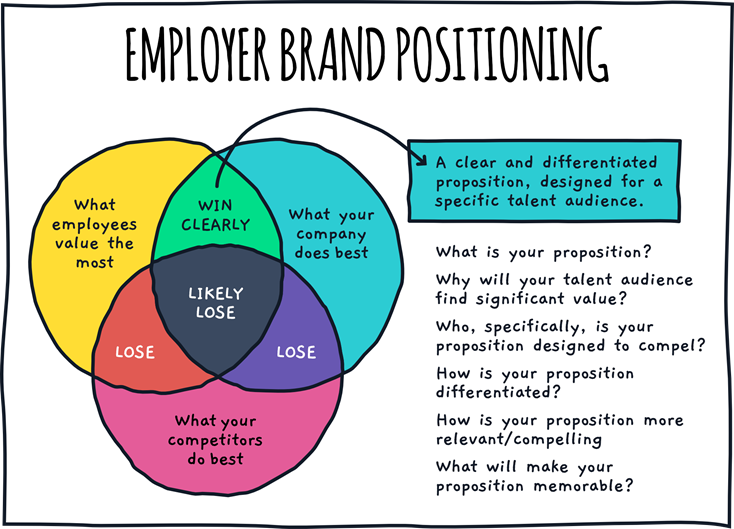Hit the Sweet Spot with Your Employer Brand Positioning
2 min read.
A critical part of your employer brand strategy is positioning - the need to develop a unique and memorable brand that speaks directly to your identified talent audience. Finding the sweet spot which will separate you from your competitors is key...
We talk about employer brand a lot. We talk a lot about employer brand strategy too. But one thing most people miss completely is employer brand positioning. Positioning is a vital piece of the puzzle and is often the key to carving out a highly effective competitive advantage.
Most organisations focus on developing their employer brand and strategy without defining their unique positioning, missing an opportunity to establish a differentiated and compelling talent proposition.
The key to successful employer brand positioning is identifying the intersection between what an organisation does exceptionally well and what its employees value most. This "sweet spot" allows companies to develop a talent proposition that leverages organisational strengths while appealing to the priorities of potential and current employees. Failure can occur when positioning focuses solely on organisational strengths without considering employee values, resulting in a disjointed or irrelevant employer brand.
Defining your Employer Brand positioning
Defining this positioning involves answering several key questions:
- What is your proposition? Summarise the main benefits and attributes that make your employer brand unique and value-adding for talent. It should be clear, concise, and memorable.
- Why will your talent audience find significant value? Outline the meaningful, tangible ways your proposition improves the employee experience and meets talent needs. Demonstrate that you truly understand target candidates and employees.
- Who, specifically is your proposition designed to compel? Avoid a blanket, generic approach by tailoring your positioning to resonate with talent personas and segments based on their values and priorities.
- How is your proposition differentiated? Articulate how your employer brand is distinct from competitors and alternatives. Highlight signature aspects of your employee experience and culture.
- How is your proposition more relevant/compelling? Explain why your employer brand is not just different, but better suited to talent needs and preferences versus other options.
- What will make your proposition memorable? Identify defining brand attributes, images, phrases or concepts that grab attention and stick in candidates' minds.
Brand positioning sweet spot
Your brand positioning should sit in the sweet spot between what your company does best and what your employees want. Whatever your competitors do best should not influence your thinking.
Strong positioning balances organisational realities and talent desires, while setting a company apart. It should align with business goals and culture, yet speak directly to employee motivations. The end result is an employer brand that authentically reflects an organisation and effectively attracts suitable talent.
With positioning defined, communication strategies can then amplify the differentiated narrative across platforms like career sites, job postings, advertising and social media. HR teams can integrate positioning into the candidate journey to create an immersive, employer brand experience.
For example, a tech company recognised for innovation may position itself as an employer that empowers employees to constantly create, experiment and improve. This taps into the priority tech talent places on cutting-edge work and creative licence.
Meanwhile, a retailer seeking customer-centric employees could position itself as a brand that provides meaningful community impact, leveraging its store locations and customer relationships. This appeals to talent motivated by purpose and social connection.
In both cases, positioning aligns with business realities while speaking directly to the values of each company's talent audience. This ultimately helps candidates see themselves thriving and succeeding in roles.
What positioning does
Beyond external recruitment, brand positioning should inform employee engagement and retention efforts. HR teams can reference positioning to demonstrate how organisational strengths deliver on aspects current staff care about most. This drives higher satisfaction, advocacy and ambassadorship.
Regular surveys and focus groups can track whether employees feel their needs are being met according to brand positioning. It will reveal any disconnects that may require culture and experience improvements. Monitoring performance metrics like turnover rates also helps you understand whether your brand positioning successfully resonates with talent.
The success of employer brand positioning ultimately depends on authenticity. Talent will see through attempts to invent or exaggerate traits that do not accurately reflect company culture. Positioning must be grounded in real differentiators, not aspirational claims that fail to deliver on employees' real-world experiences. Credibility comes from sticking to truths that set an organisation apart while speaking to talent priorities.
Clearly defined brand positioning allows employers to craft compelling, relevant talent propositions rooted in organisational strengths and employee values.
This unique intersection becomes a competitive advantage. Developing a smart positioning strategy can elevate your employer brand, sharpen talent attraction, and form the foundation for impactful communication and experiences. It is not only about what you say, but how you position yourself in the mind of your talent audience.